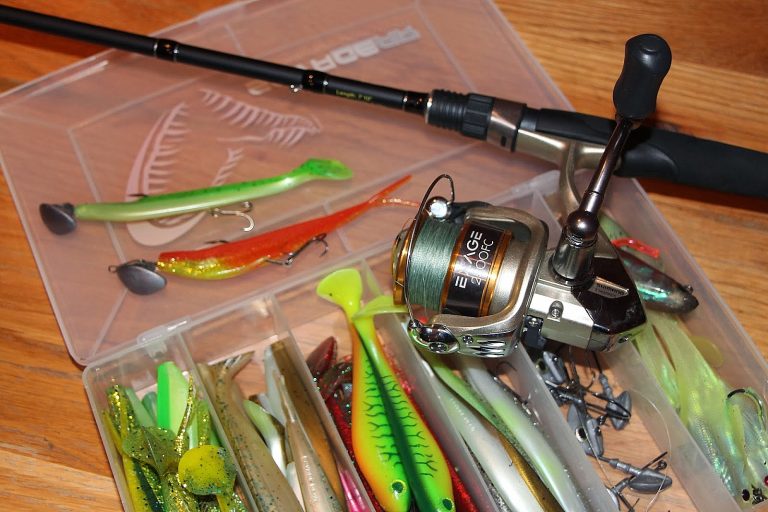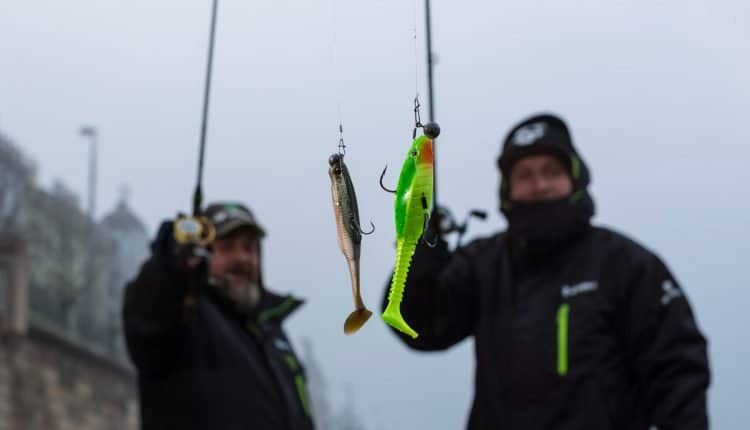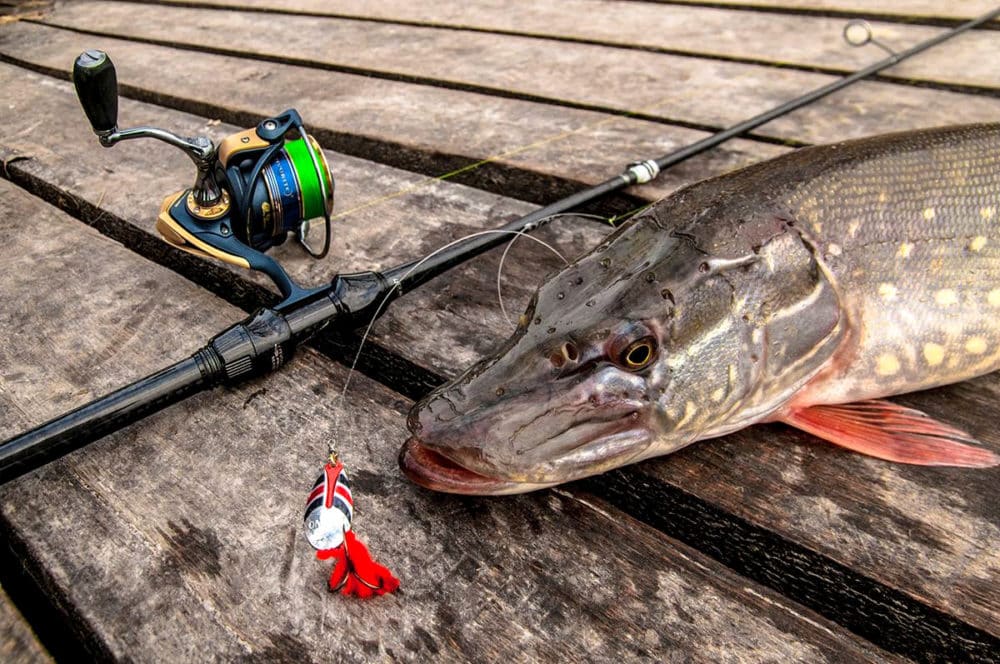Jigging pike stands out among other spinning methods. This business has its own philosophy and buzz, its own rules and its own pitfalls. You can catch pike with jig lures almost all year round and in almost any conditions – since the choice of models, mounting options and animation methods for rubber / foam rubber is huge and allows you to close all fishing and fish “Wishlist”.
- When and why a jig is good: advantages
- Features of fishing for pike with jig lures, depending on the season
- Jigging for pike in spring
- Summer fishing on “silicon”
- Features of jigging for pike in the fall: choosing a bait, finding a predator, posting
- What you need to know about pike jigging – interesting and informative
- Fishing for pike with silicone lures: search, tactics of behavior on the water
- Pike fishing with unloaded rubber
- The best silicone pike lures – versatile rubber that works
- Jig rigs used for pike fishing
- Jig heads – which option to choose for pike?
- What should be the tackle
- Поделиться ссылкой:
When and why a jig is good: advantages
- Variety of lures and mounting options . The size from 1 inch to 5 and more allows you to seduce any pike from a 100 gram lace for a microjig, to a dozen “mother” for a huge ripper or worm. Various colors allow you to fish at any time of the year and at any depth. Various rigs and types of installation allow you to fish out any even the most difficult bottom relief, – among snags and stones, a mulish bottom, and others. Spacer rigs are more catchy than conventional jig rigs in some cases.
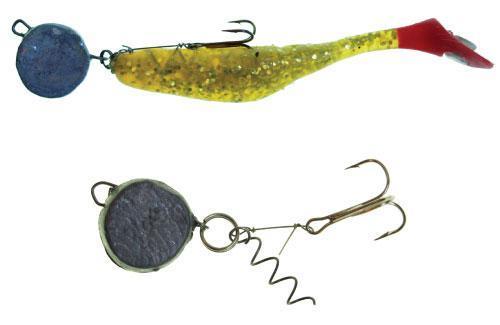

- Versatility . It follows from the previous fact. It is possible to jig for pike all year round – in spring, summer and especially effectively in autumn before freezing and in almost all conditions.
- Edibility as an additional seductive factor. Neither wobblers nor spinners can boast of such quality. It is the edibility that allows you to seduce the most passive fish and get away from zero.
- The ability to fish at great depths and large waters . A jig on powerful tackle and heavy loads allows you to fish the most inaccessible pike sites – channel edges, pits, bays, reservoirs. Moreover, this can be done incomparably faster than wobblers or spinners.
- Quick change of depth of wiring . There is no need to change the rubber bait, it is enough to change the weight-Cheburashka and the bait will go a meter or a little deeper / shallower.
- Relative cheapness and availability . Silicone baits cost much less than wobblers and iron spoons and spinners. This means you can assemble a set with wide capabilities for all occasions.
lifefishing. And also you can not be afraid to tear off the bait and fish the most promising places, which are often the most snagged.
Features of fishing for pike with jig lures, depending on the season
Features of jig fishing differ greatly depending on the season – in spring, summer and autumn, pike prefers different sites, different lures, rigs and options for their animation.
Jigging for pike in spring
Before spawning, the pike walks in the reservoir with caviar in search of a place for spawning, it is sluggish and has no time for food, the belly is clogged with future offspring – the toothed predator often ignores large rubber. Give her something smaller, but slower. In the spring post-spawning time, the predator is still sick after spawning, and is not yet ready to hunt for large baits. It is worth trying at this time to fish for pike with small worm-like lures, for example, Javastik from Imakatsu, Crazy Fish Polaris, Reins Aji Ringer, Bait Breath Needle, Tsunekichi Worm and others in the size of 1-2 inches. And also on small rippers in the same size – Pontoon 21 Awaruna, Keitech Swing Impact, classics – Hoof from Relax and Predator o Mans, as well as others.
Interestingly, unlike in autumn, in spring, the pike prefers slow wave-like postings, without sudden movements. Dragging along the bottom and at the bottom, an easy lazy step. This should be taken into account by “spring workers”.
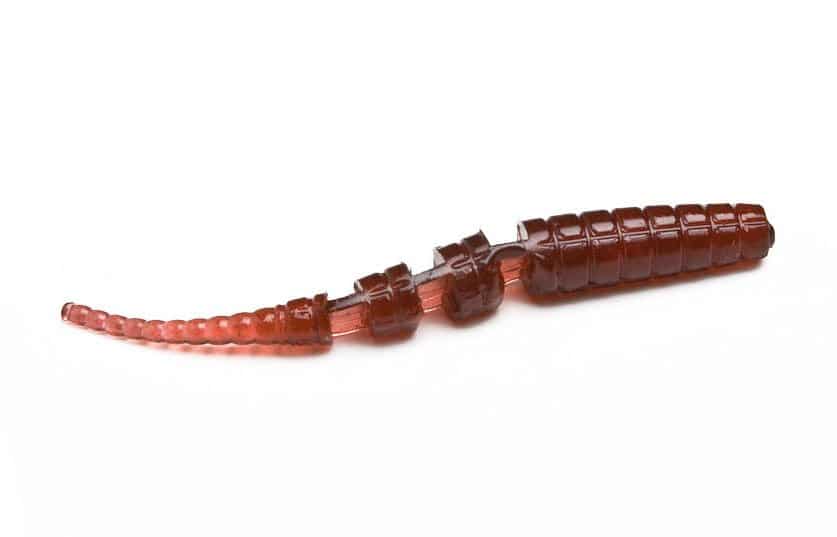
Carefully observe the surface of the water. Often the toothed beauty gives itself away with splashes and a scattering of silvery fry.
In the spring, options for inactive animation are used. A slow step, pulling along the bottom and in the water column using a rod, actively playing jigs show themselves well on uniformity.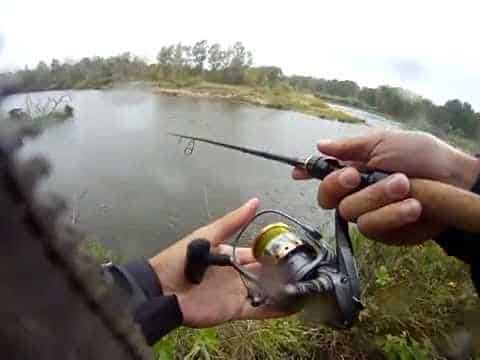
Summer fishing on “silicon”
In summer, the water warms up. June-July is one of the most difficult months in terms of trophies. Summer pike is best caught at dawn. Weather factors have a great influence on its activity
. Rain, breeze, coolness, fog – what you need for successful fishing.
In general, in the summertime, the worse the angler is, the better the fish.
On stagnant water bodies – bays, oxbows, floodplain lakes, pike in the summer should be looked for with the help of active and passive rubber on a load of 5-10 grams along water lilies, above nettles, along the coastal edge and at a drop in depth.
Important! The weight of a jig head or cheburashka is selected depending on specific conditions. So that the silicone goes in the right water horizon at the required wire speed.
If the heat is completely unbearable, then it is worth tapping with a step and the bottom of the reservoir. If the reservoir is muddy, then it is worth making a step at a distance of 30-50 cm from yes. In summer, pike migrates through the reservoir, and if it is quite obvious where to look for it in stagnant reservoirs, then on rivers you need to experiment with the casting point, angle of attack, baits, animation. On small and medium-sized rivers in summer, fishing from a steep bank, where the depth, return flows and potholes in the coastline are usually located, will be effective. Casting is done either along a slow current along a steep coast, or across the current. In the latter case, the casting is done almost at the very edge of the opposite bank – most often there is a sandbank there. Thus, with the help of a step or toss, all possible summer pike sites are tapped – a sandbank, coastal edges, channel edge,irregularities in the bottom relief and finally a pit or pit under a steep bank. In summer, it is worth using a wide range of baits – active rippers and sheds, twisters, passive and active food. The most common size is 2-3 inches. The colors largely depend on the place and conditions of fishing (more on the choice of lures below).
It is in the summer that it makes sense to use edible rubber on warm water, at this time it fully reveals its qualities. The first is that a passive predator can sometimes be lured out only for a “tasty treat”. Second, attractants work to their maximum during the warm season.
Seemingly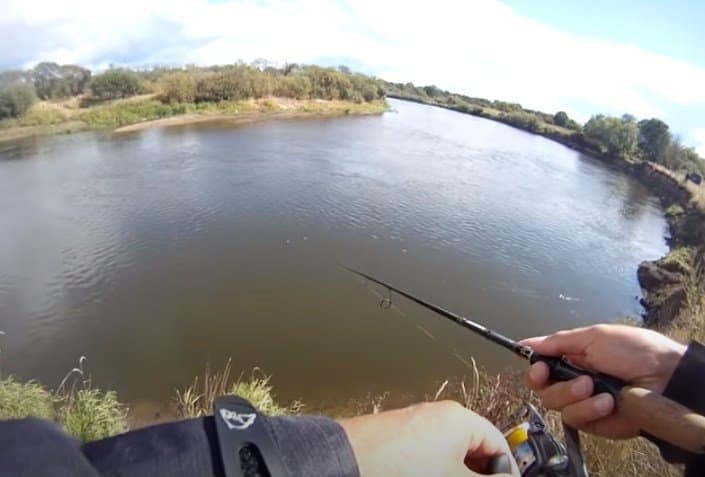

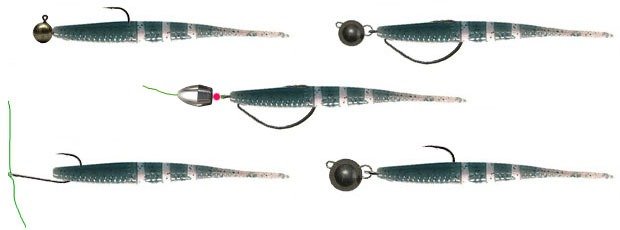
Features of jigging for pike in the fall: choosing a bait, finding a predator, posting
Autumn can be conditionally divided into two periods, each of which has its own characteristics. The first is early autumn (mid-August to mid-September) and the second is late autumn (mid-September to November before freezing). If in late summer and early autumn the water is still warm and the habits and sites of the pike are in many respects similar to the summer ones, then in late autumn it rolls down to the deepest places of the reservoir – pits, channel and coastal edges and places of entry into them. Details on the
habits of pike in late summer and early autumn in our article… In autumn, you often have to fish at great depths in cold water. At this time, it makes sense to use active rubber – rippers, shads, twisters with their own active play. The colors are acidic, bright, catchy. Red, silver, yellow, green, fluorescent and interspersed with sparkles. The classics of rubber for pike in the fall are Relax Hoof, Relax Aqua, Mans Predator, Mans Assassin, Bass Assassin, pike
vibrotails Akara, Pantun 21, Lucky John and others.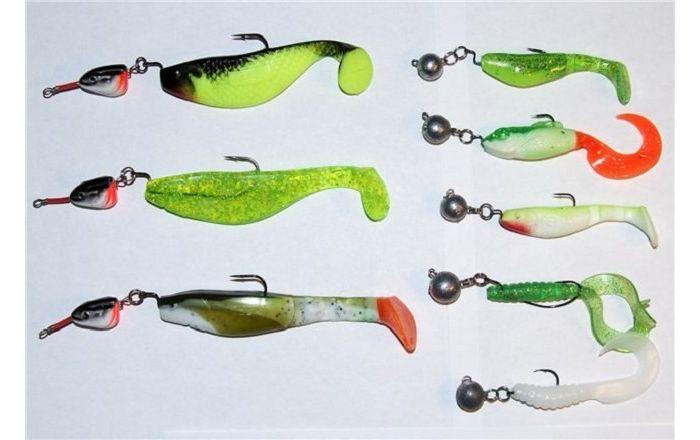
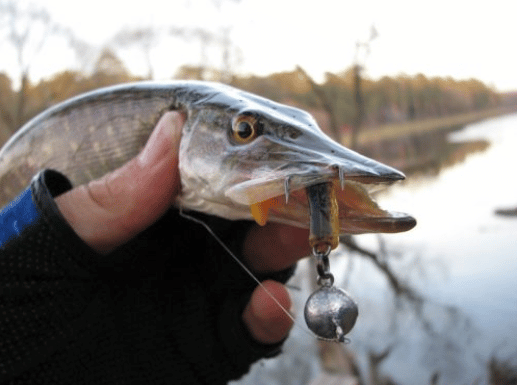
For autumn fishing, it is worth taking various sizes, shapes and colors of working lures. As well as accessories for various types of non-engaging rigs.
https://youtu.be/BRNk93U29gI
What you need to know about pike jigging – interesting and informative
It is not enough to find a pike, it is not enough to find a working bait, it must be fed correctly. There are several animation options for jig lures, the rest are variations on the theme. About jig wiring: https://youtu.be/iivKj_ofTlk Basic jig wiring:
- Classic step . It can be done both with the tip of the rod and with the help of a reel. In the first case, after the jig has touched the bottom, a sharp undermining of the bait is made from the bottom – a pause – the sag of the cord is selected. And so in a circle. Often the bite follows on pause or at the moment of detonation. The second version of the classic step: the bait touches the bottom, 2-4 quick turns of the coil are made – a pause – the sag of the cord is selected. The rod turns out to be more aggressive, the reel is soft.
- Long step (double / triple / quadruple step). The bait sinks to the bottom – an undermining is done with a rod, the line is quickly selected and preventing the bait from falling, another undermining is made and so on from 2 to 5 times. Then the jig is lowered to the bottom and everything is repeated. In this case, the bait moves in a step in the water column. You can play with the number and length of the steps.
- American . The cast-bait falls to the bottom and the slack is taken out. Spinning stretches are made, but not sharp, as in the classics, but smooth, as if stretching the bait along the bottom or at the very bottom. The posting is lazier and suitable for passive fish and warm water.
- Jumping along the bottom . Small-amplitude and high-frequency jumps at the bottom. Realization – small continuous jerks with a rod practically without pauses.
- Wave-like . It is carried out using a coil. The rotation speed varies, which sets the wave-like motion of the bait, but without the jerk component. You can touch the bottom or not.
- Demolition wiring . Option for the flow. The cast is made across the stream or slightly higher. The weight of the load is selected so that the bait is dragged along the bottom. At this moment, the cord is exhausted from the angler’s side. It turns out that the silicone moves in two projections, actively raising a cloud of turbidity at the bottom. Very good animation for cold water, passive fish and large areas.
- Uniform . The most common uniform winding in a given water horizon. With the help of pauses, you can vary the depth of the lure’s immersion even on one cast.
- Dragging along the bottom . This type of posting is used for the most passive fish, when the predator does not respond to other types of animation. Combined with rather long pauses. Works well on edible passive rubber.
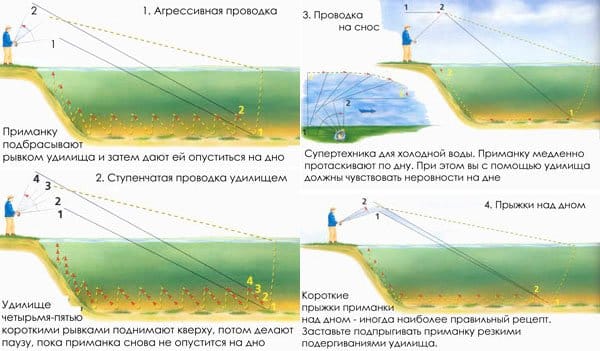
Fishing for pike with silicone lures: search, tactics of behavior on the water
Video to fix the topic and feel the buzz, albeit remotely. Fishing for pike and perch on silicone: https://youtu.be/jxx0s6lQ2kc Video about jigging pike on a small river: https://youtu.be/9mDKe5l8EmM Spinning pike fishing from a boat on the Desna on silicone: https: // youtu .be / 5wE1TURCeo0
Pike fishing with unloaded rubber
Fishing for pike on unloaded rubber stands out among other methods of jigging, but we will talk about this in a separate article. Now, briefly in video clips from the pros: https://youtu.be/R2ay7iEKJKE https://youtu.be/EDdG5YMN5wc
The best silicone pike lures – versatile rubber that works
Depending on the season, water body, weather, pike prefers different types of jig lures – the gradation is by type, size, body shape, activity / passivity, color and other factors. It is not possible to bring all the factors together, this experience is gained over the years and many factors have an influence on the choice of a particular bait in a particular situation. There are no one hundred percent dogmas when choosing the “best” silicone bait for pike, there is a subjective choice depending on the conditions, which is based on practical experience of use, as well as some axioms that should be adhered to, but not blindly believe in them:
- In spring and summer, baits are used of a smaller size than in autumn in relation to one reservoir.
- In muddy and deep water, the colors are more poisonous and interspersed with sparkles.
- On transparent water of color-imitation of food base.
- Acid colors, like provocateurs on the grip when nothing else works.
- Autumn is the time for active baits.
- Passive fish are passive baits. Active – active.
- Driving rippers are more suitable for flow than shads.
- Always use a commensurate weight for the bait. A 20-gram head on a 1-inch silicone fish looks ridiculous.
- Use quality soft rubber baits. Which play well even at low speed.
- The best bait is the one that the spinning player understands and believes in!
- Experiment.
So, for example, the color of silicone on a river “brow” pike in the fall implies the use of sparkles in the composition, due to the fact that it is often necessary to fish at great depths, and in overgrown swamps matte colors will be good – cloudy with red, dark yellow, machine oil.

- Man’s Predator 2-5 inches . Universal working small, medium and large rubber for pike. The size is selected based on the fishing conditions. On oxbows, it works 2 and 2.5 inches along the water lilies all year round. The pearlescent blossom was especially good. On the pits and edges, 3-4 inches are good, especially in the fall. For trolling 5.
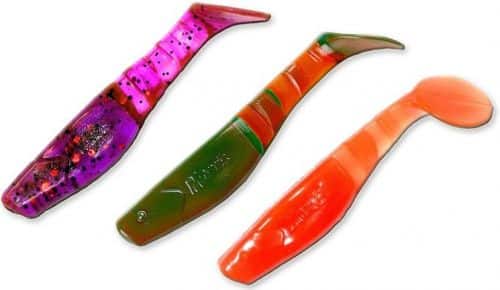
- Mans Assassin ( Man of Assassin’s ). Has a more active play compared to the Predator due to the reverse notches on the tail. Often more catchy than his fellow.
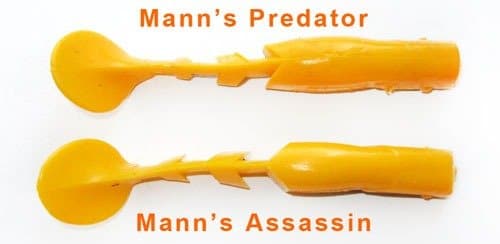
- Relax Kopyto . 2-3 inches. Classic. Small two-inch ones in color S002 mow the pike on the oxbows. Larger models along river edges and holes.
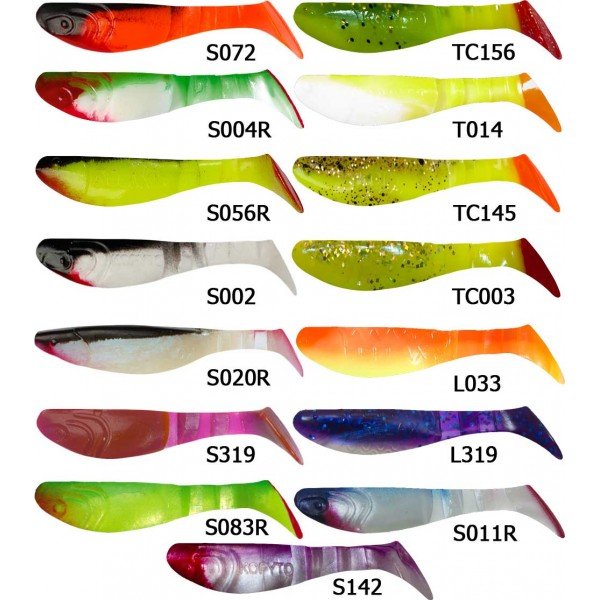
- Relax Aqua . Very decent tires from Relax. Application in pits and pits, slow rolls. Stubborn.

- Bass Assassin Turbo Shad . An active game, a wide range of colors. The massive penny provides wide-amplitude oscillations. On the pits on a jig or hinge with a bullet is a great option.
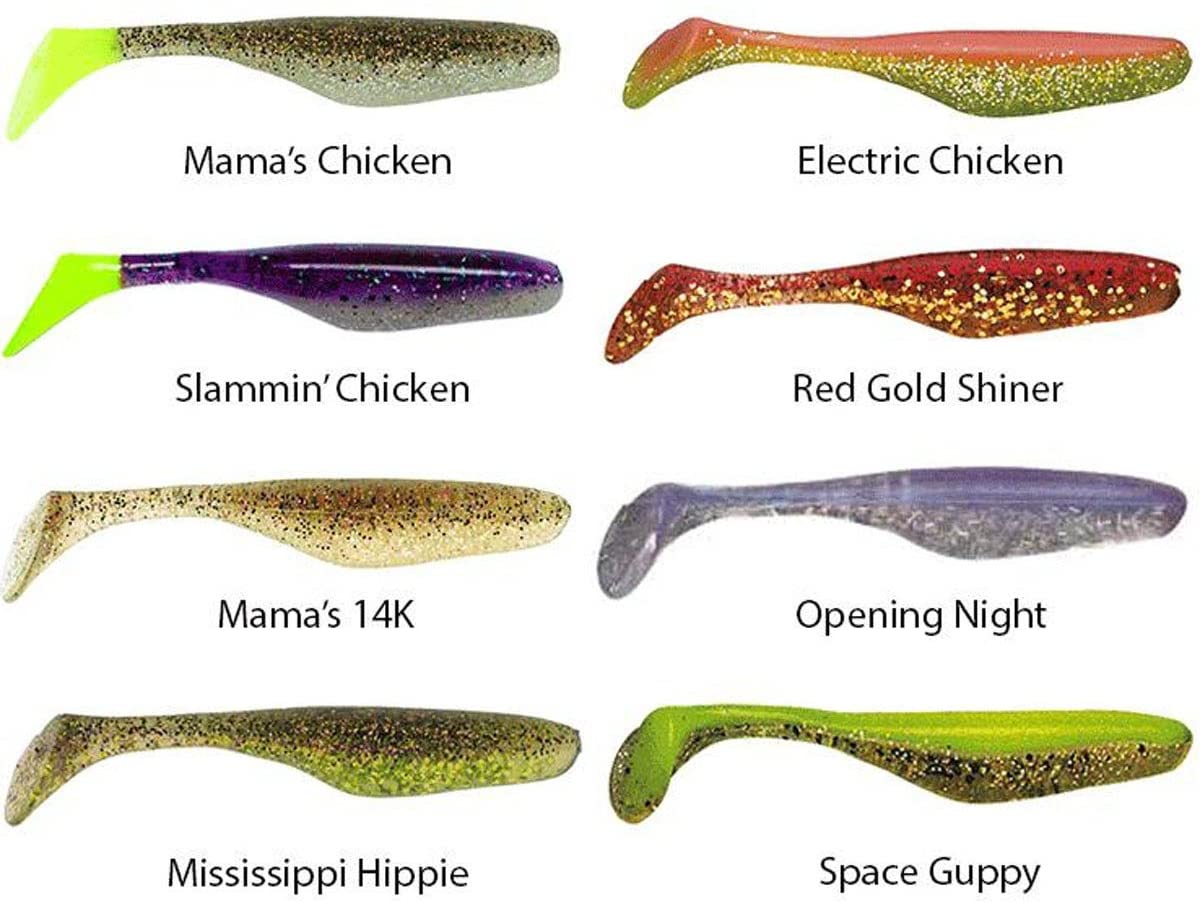
- Pontoon 21 Awaruna. 3.5, 4.5 . A wide range of colors for any conditions. Floating initially. It is good to use in installations that will provide the bait with the position of the feeding fish – spaced, heads like an iron and a spoon.
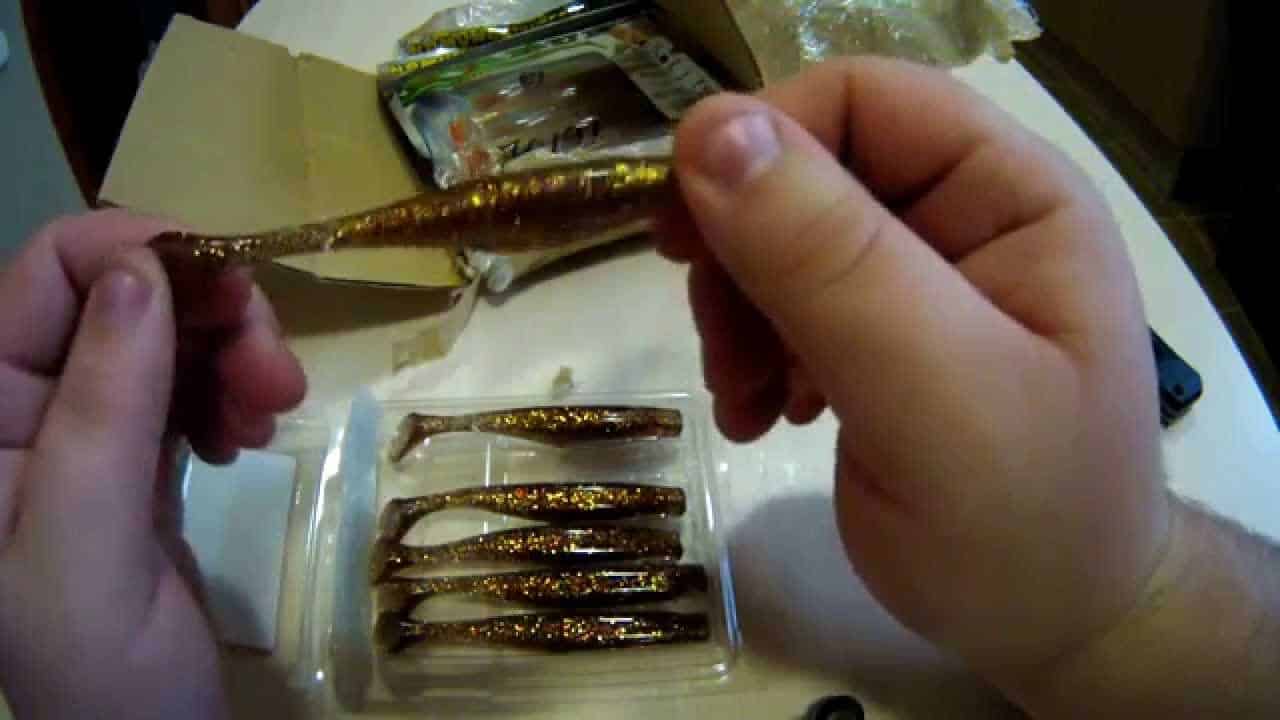
- Lucky John Joco Shaker . Edible silicone vibrotail with a ribbed notch on the body. Works on a wide variety of installations.
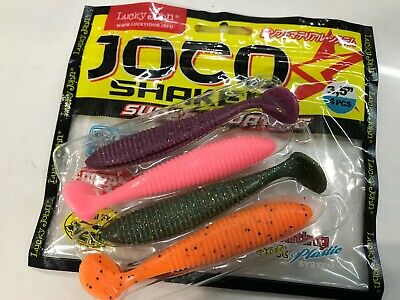
- Lucky John Tioga and Lucky John Tioga Fat . The ribbed notch provides the lure with active play at the slowest drive. Works well on uniform, step, bottom jumping and in the water column. Recommended!
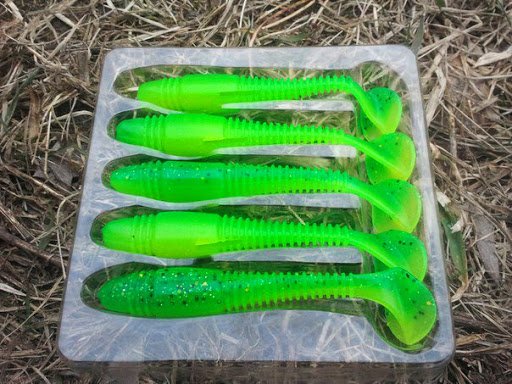
- Lucky John Long John 3.1, 4.2 inches . Pulling vibrotails. They have shown themselves well in conditions when it is necessary to quickly work out a new water area at different depths. Fan casts on articulated mounting. Mid-frequency vibrations and side swaying.
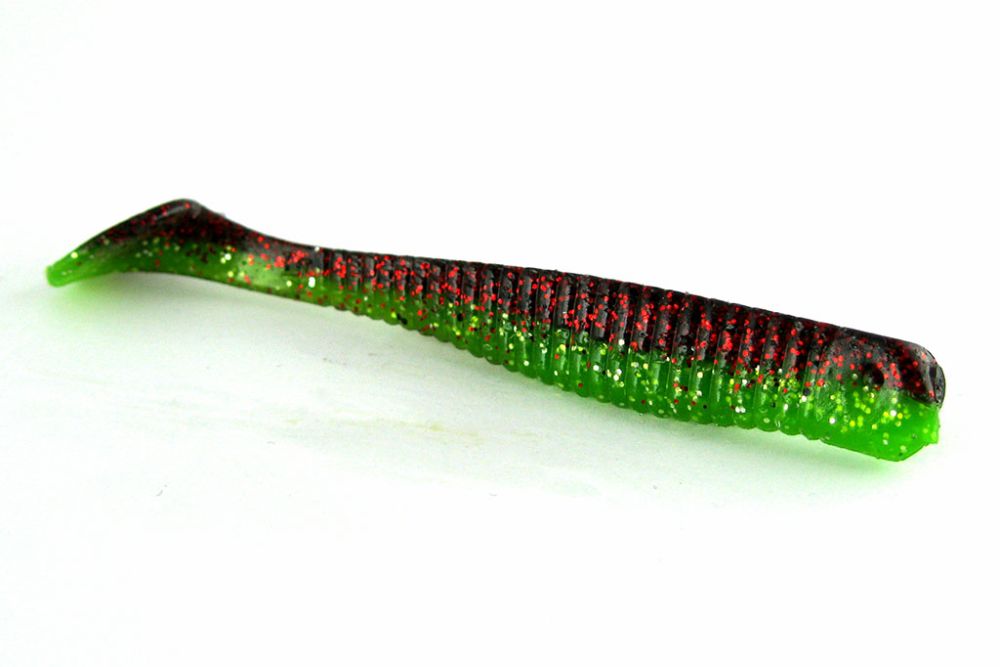
- Sawamura One Up Shad 3-5 inches . An innovative edible vibrotail with an unusual shape. There is a tie in the middle of the body, which enhances the vibrations of the tail on the harness. The bait is interesting with its play on slow wiring. The fish is constantly in a staggering state, the impression that it is wounded and rushing about. Of the minuses (and pluses) – very delicate and loose rubber. The bait literally melts in your hands. And this gives the maximum realism in the water, but the bait rarely manages to survive more than 2-3 bites. Installation – jig head, cheburashka, diverter, karolinka and texas. The bait is floating, therefore it can be used in rigs – without load, on a spoon-type head, and all kinds of leashes.
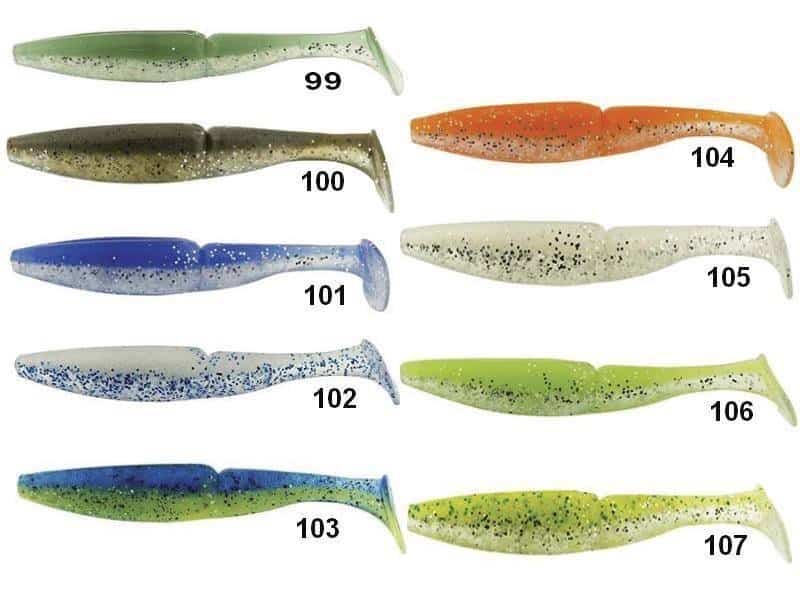
- Jackall Knuckle 3.5 . Edible silicone vibrotail from Jakal. The heavy heel delivers high-amplitude low-frequency vibrations in the slowest drive. What the toothy loves. The range of colors is not very pleasing, there are no “flashy” colors. But for freshwater conditions, what is enough is enough. Very tenacious bait. There is a slot for more convenient positioning of the offset hook.
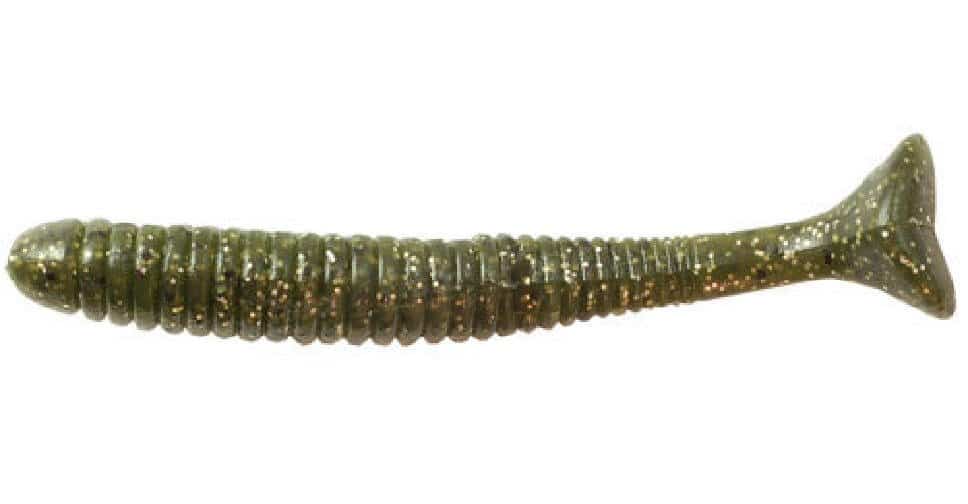
- Keitech Swing Impact and Keitech Swing Impact Fat . The entire lineup. Very soft and very edible vibrotails. The first one has a small-amplitude and more frequency play, the second one, due to a wider body and a massive penny, has a high-amplitude and low-frequency one. Of the minuses, it is quite expensive.
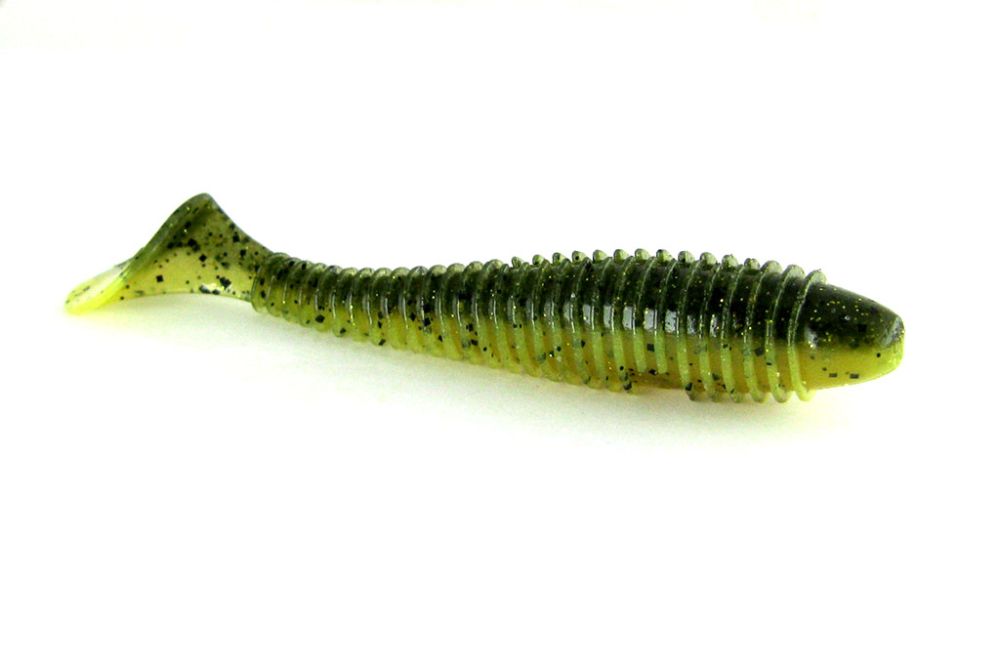
- Reins Curly Curly. 3.3 . Custom twister. It is very good in places where clean water is 20-30 cm, and then there is grass in which pikes stand waiting for a victim. It flies well enough even on a 3-5 gram head. The game is interesting – slow waving gives small vibrations of a massive tail, faster spiral wave-like animation.
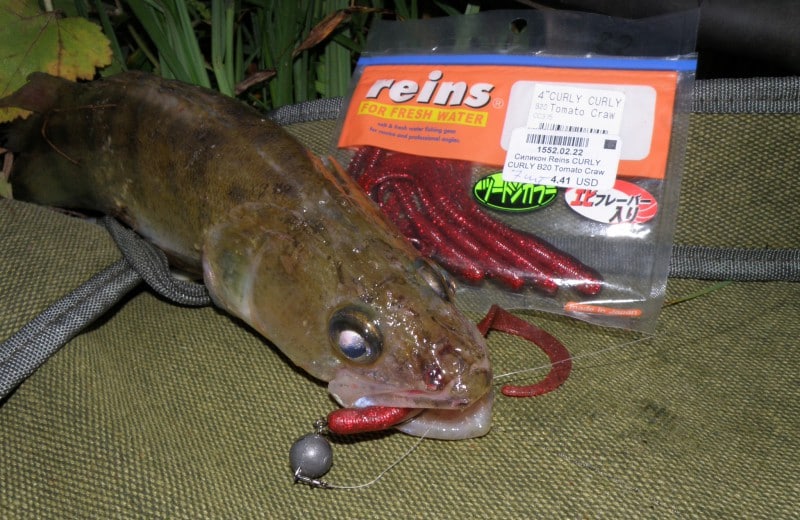
- Keitech Easy Shiner 3, 3.5 and 4 inches . Edible ripper. Good on spaced rigs and classic jigs. There is a notch for offset. We use it in pits and pits.
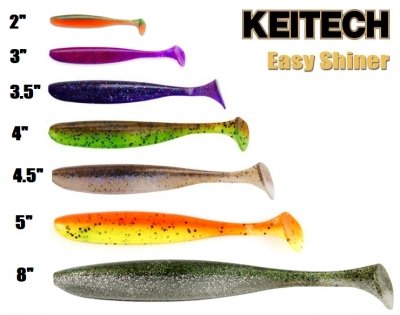
- Imakatsu Javastick 3.4 inches . We recommend using this slug for passive pike, rubber has shown itself well on rigs such as eyelids, drop-shots, karolinka and classic cheburashka. A must-have for a beginner “sweetheart”. It is better to start learning something new with something working, so as not to be disappointed ahead of time. Pricey but worth it.

It is worth noting that we have selected silicone baits with different prices. From budget Kosadaki and Lucky John, to expensive vibras from Keichi and Jakal. It seems reasonable to use cheaper models for snagging, and expensive ones in proven places and for offset montages.
Jig rigs used for pike fishing
Jig rigs differ in a variety of solutions. There are two main ones – blind rigging on a jig head of various types and rigging on a Cheburashka – a long-eared sinker.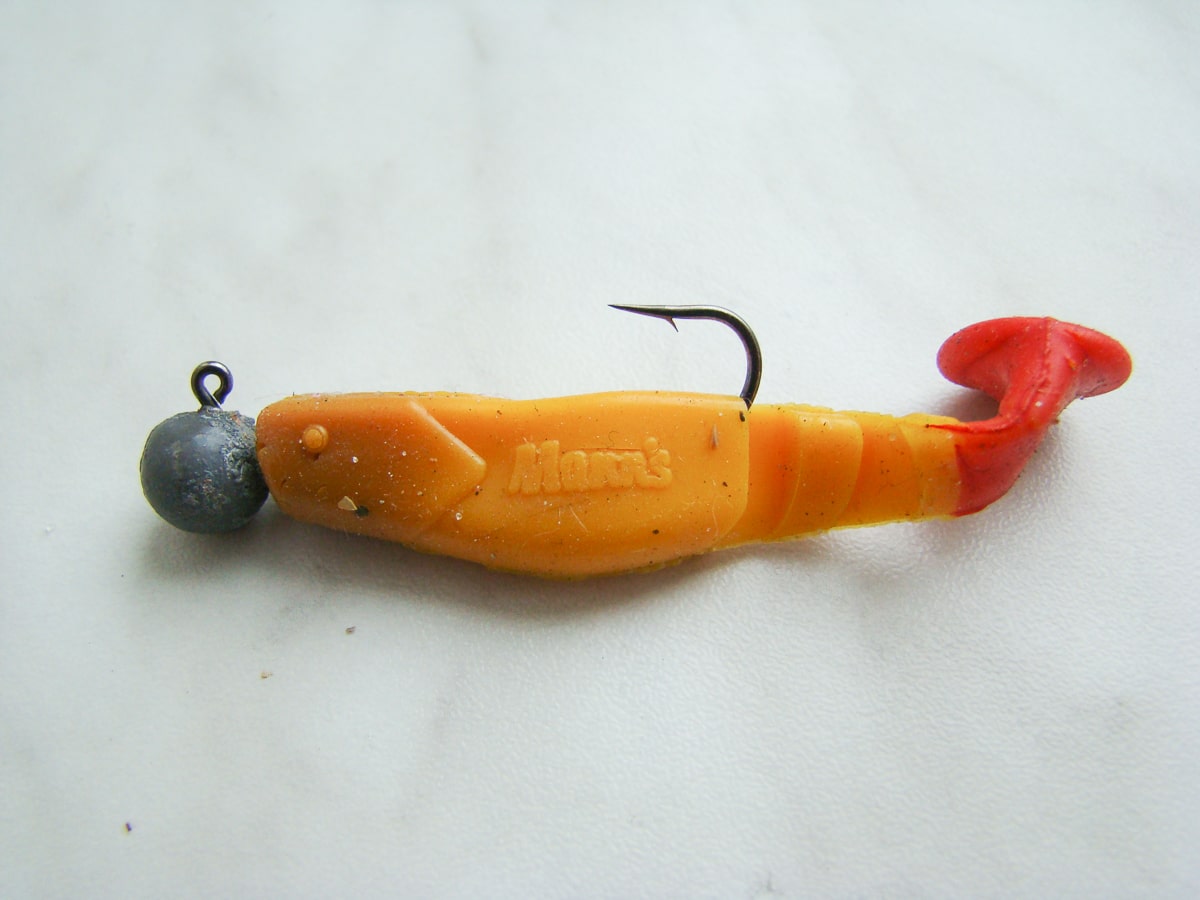
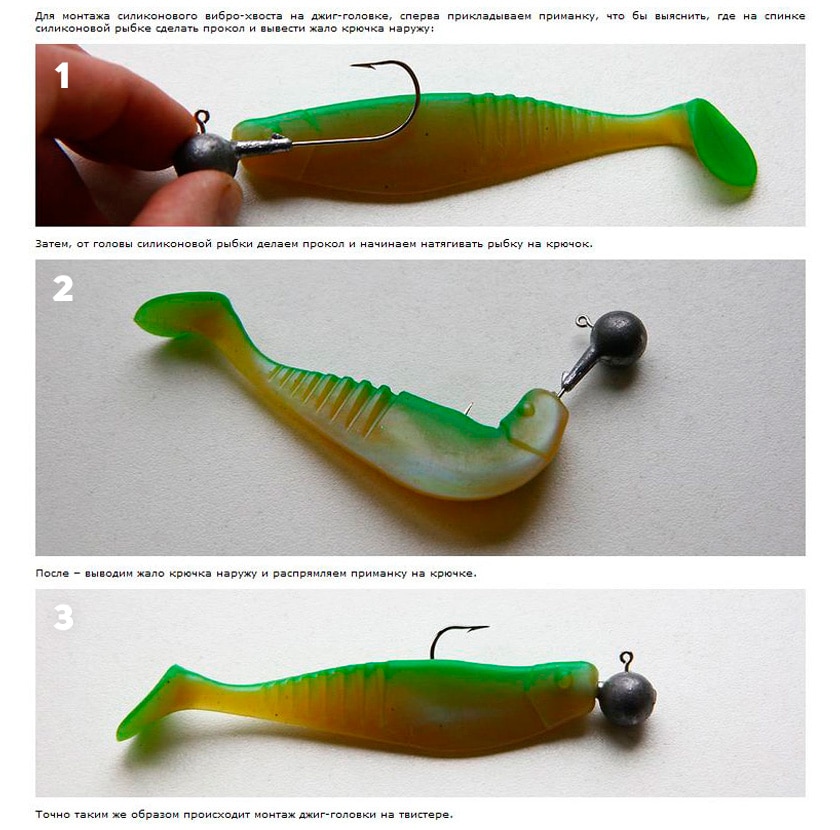
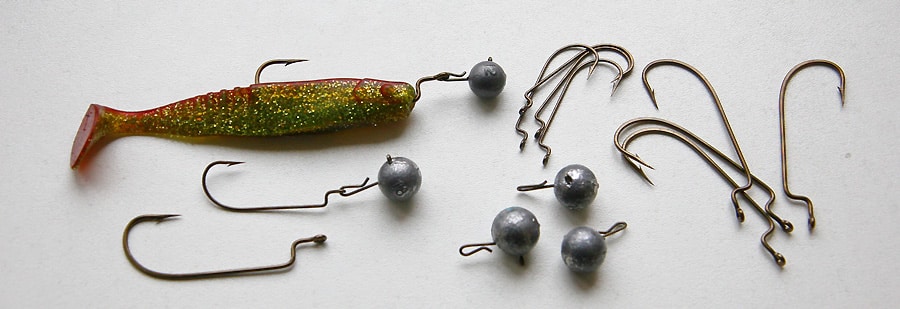

When is it better to use a swivel joint and when is it better to use a blind rig? If it is necessary to use large weights of the load with relatively small baits (pits, channel edges), then the hinge is in the favorites – it gives more freedom to the bait. Otherwise, you can use the jig head as a more compact version of the rig. While there are athletes who only use the swivel joint, this is more a matter of taste.
There is also a wide variety of different jig rigs for pike, which are not the topic of this article, and we will go through all of them in more detail, now we will list them with a photo:
- Texas rig.
- Carolina rig.
- Retractable leash.
- Drop shot.
- Wecky.
- Tyrolean stick.
- Jig rig.
- Unloaded rubber.
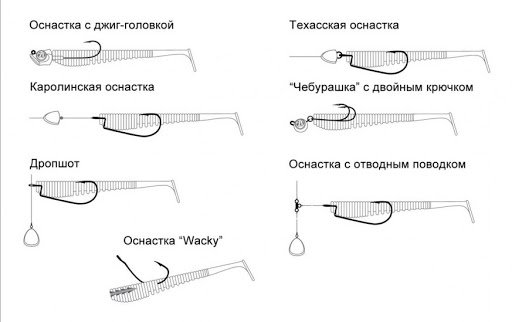
Jig heads – which option to choose for pike?
There are many options for the jig head shape: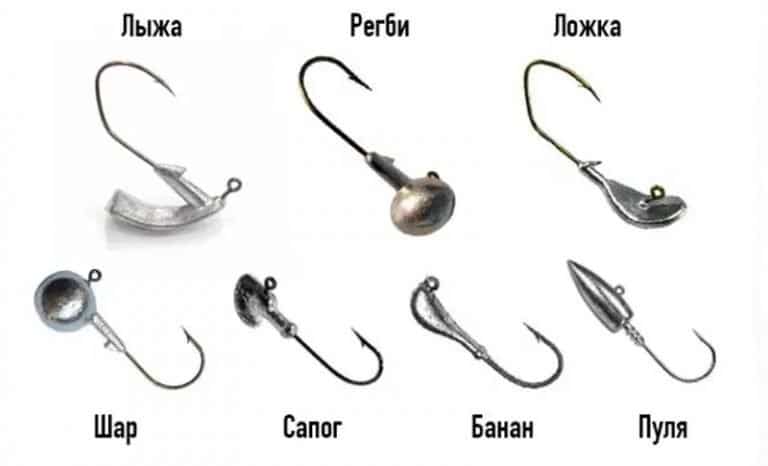
- Ski and spoon . When using such baits, the head at the bottom is located at an angle, and with it the bait, which imitates a fish feeding at the bottom. The ski gives a larger angle, the spoon gives a smaller one. Such heads are good when fishing on shallows and if the bottom is muddy, or strewn with small stones.
- Standard ball . A universal and most common form. Used everywhere. Of the minuses – at the bottom, the bait falls on its side. Which reduces the attractiveness of the silicone and the fish detectability.
- Rugby . Unlike the standard round head, it always keeps the jig upright at the bottom. But it is not popular due to the fact that it reduces the compactness of the bait – and this interferes with casting, increases the likelihood of catching and collecting algae.
- Bullet . It is used with slender lures – worms, thin rippers, slugs. Good flight performance, collects less small algae.
We recommend using both jig heads and offset and regular hooks from Decoy and Gamakatsu for pike by manufacturers. This is the quality from jig to jig. Sharp, break-through, hold the bait well. Available in different shapes, weights, with different forend lengths and hooks.

An additional plus of the Japanese Jamakatsu heads, which is especially when fishing for pike in strong places, is that their hooks bend when loaded on a kink. What does this mean in practice? The fact that the fish will not be able to break or unbend the hook, but when it is hooked on the snag with the sting of the hook, you can unbend it with a sufficiently powerful tackle and save the bait. This process can often be repeated 2-3 times on one head, then it breaks.
The weight of the jig head should be selected based on the depth of fishing and the required wiring horizon, as well as the size of the silicone bait. Selected empirically. Average:
- 1-2 inches bait. 4-6 gram head.
- 2-3 inches. 8-15 gram head
- Over 4 inches. from 15 and more gram head.
What should be the tackle
For jig fishing, there is the so-called class of jig rods. These rods have an extra-fast action, they are quite “evil” and sharp, both on a typical “step” and when casting and playing a predator. But such spiked sticks are more suitable for catching bony pike-perch, while on pike it is better to work with a half-parabolic spinning rod or an average between fast and semi-parabolic action. This form knits the pike better and prevents it from spitting out the bait on the candle. An additional bonus of a soft stick is that it is more throwable and allows you to perform long and accurate casting, which is often necessary in jig fishing. A jig spinning rod should have what the spinning community calls “sonority” and “chuechka”. Clearly convey everythingwhat happens to the bait under water is to tap the blows on the bottom of the hand, the angler must read the relief, hooks for algae and the most careful bites through knocks on the hand.
So what should you choose? Ideally, have two spinning rods for jig fishing – fast and semi-parabolic action, each for different conditions. It should also be borne in mind that coastal spinning in most cases should be longer than for fishing from a boat. With all this, the coil can be the same. But not everyone has the financial ability for such a luxury and often has to choose one thing.
The test is selected based on several components:
- the weight of the alleged baits;
- the weight of the estimated prey;
- the type of reservoir – the depth of fishing, the strength of the current and whether it is absent;
- aggressiveness and type of wiring;
- the need for long casting.
A usual station wagon for small and medium rivers of the Russian Federation and the CIS, according to the test, is usually light and higher: 3-18, 5-21, 10-30, 10-35 grams. Composite or carbon, depending on angler experience and financial ability. If you have to fish in difficult places where forced fishing is necessary, it is worth throwing 15-20 percent on the test in order to have a margin for maneuver. These are rivers with numerous snags and stone ridges. The reel is always matched to the blank – a balance must be struck. The quality of the cord laying is also of great importance – otherwise beards, mustaches and overlaps are inevitable with jerky leads. Sizes 2000-2500 according to Shimano classification. Diameter 0.12-0.15. Recommended manufacturers – Daiva, Shimano, Spro, Ryobi.